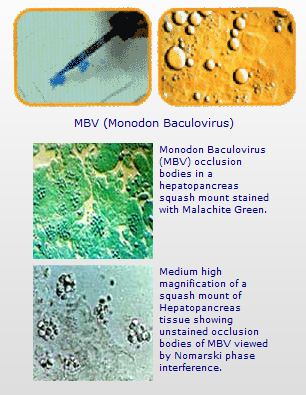MBV (Monodon Baculovirus)
The occlusion bodies (OB) formed as Monodon Baculovirus (MBV) replicate are easily visible using a microscope. There appear to be more OB when PL are stressed, so the presence of OB can be taken as an indication of stress in the PL. But the absence of OB should not be taken as the absence of MBV infection, since the virus can be present without forming OB. If MBV OB are found, improving tank conditions often reduces the OB prevalence.
This tissue of MBV has become a serious one in India, where many farmers believe the presence of OB indicate infection with White Spot Syndrome Virus (WSSV) or that the MBV will, cause stunted growth. Although we use the ex tent of the OB to determine the effectiveness of egg and nauplius washing-if a lot of PL have OB, it is likely the hatchery’s egg nauplius washing is ineffective-there is no correlation between WSSV and the presence of MBV OB.
Similarly, although MBV causes some stunting under certain conditions, in most cases, it has little effect on commercial performance. When we conducted studies on MBV in Thailand in the early 1990s, the yield and growth rates were excellent, despite a prevalence of MBV OB in PL of over 90%. In fact, we found it difficult to demonstrate any impact of MBV, as the difference between ponds within both the infected and uninfected groups was far greater than the difference between the two groups.
As a farm manager, rejecting a batch of PL solely on the basis of MBV OB would have been commercially disastrous. Apart from the stocking delays while waiting for an OB free batch of PL, the farm production would be well within our operating standards. In any case, the problem is easily solved by improving the hatchery or nursery tank conditions to reduce the stress and pre valence of the OB to an acceptable level. Although, ideally, we would prefer PL free from MBV, it is probable that rejection of PL solely on the basis of MBV limits the availability of PL that are perfectly capable of good yield and performance in the ponds.




